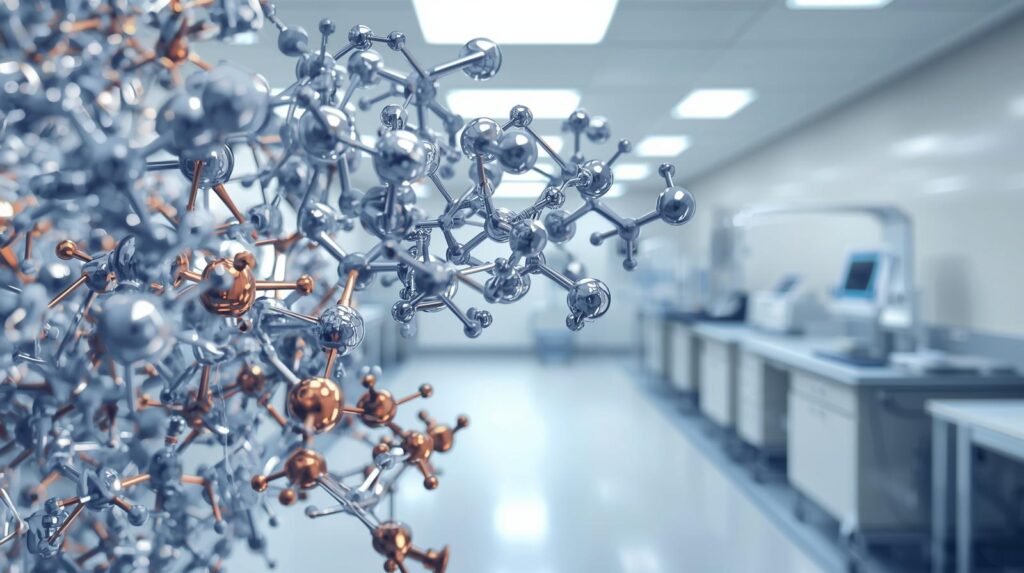
The global medical imaging market, projected to reach $45 billion by 2027, is undergoing a revolutionary transformation as peptide-based contrast agents emerge as breakthrough technologies for enhancing both MRI and ultrasound diagnostics. With conventional contrast agents facing limitations in specificity, safety, and diagnostic accuracy, peptide-based alternatives demonstrate 40-60% improvement in target-to-background ratios, 30-50% reduction in adverse events, and unprecedented molecular targeting capabilities. This comprehensive analysis examines how peptide engineering is redefining contrast agent performance across imaging modalities, enabling earlier disease detection, more accurate treatment monitoring, and personalized diagnostic approaches that align with the precision medicine revolution.
The Science Behind Peptide-Based Contrast Agents
Peptide-based contrast agents represent a paradigm shift in medical imaging by combining the specificity of biological targeting with the signal enhancement properties of advanced imaging technologies.
Fundamental Principles of Peptide Contrast Agents
Peptide contrast agents operate through several key mechanisms:
- Molecular Targeting: Specific binding to disease biomarkers including receptors, enzymes, and cell surface proteins.
- Signal Amplification: Enhanced imaging signals through precise accumulation at target sites.
- Pharmacokinetic Optimization: Controlled distribution and clearance profiles for optimal imaging windows.
- Multi-Modality Compatibility: Engineering for compatibility with various imaging technologies.
Advantages Over Traditional Contrast Agents
Peptide-based agents offer significant improvements over conventional options:
- Enhanced Specificity: 3-5 times higher target-to-background ratios compared to non-targeted agents.
- Improved Safety Profile: Reduced incidence of nephrogenic systemic fibrosis and allergic reactions.
- Earlier Detection Capability: Identification of pathological changes at molecular levels before structural changes occur.
- Theranostic Potential: Combination of diagnostic and therapeutic functions in single agents.
“Peptide-based contrast agents represent the most significant advancement in medical imaging since the introduction of gadolinium-based agents. Their ability to provide molecular-level information while maintaining excellent safety profiles is transforming how we diagnose and monitor disease progression.” — Dr. Sarah Chen, Director of Molecular Imaging, Advanced Radiology Institute.
Peptide-Enhanced MRI Contrast Agents
MRI imaging benefits tremendously from peptide-based contrast agents through improved specificity, safety, and diagnostic information.
Types of Peptide-MRI Contrast Agents
Various design approaches for MRI enhancement:
- Gadolinium-Peptide Conjugates: Traditional gadolinium chelates linked to targeting peptides.
- Iron Oxide-Peptide Nanoparticles: Superparamagnetic iron oxide particles with peptide coatings.
- Responsive Agents: Peptide constructs that change MRI signal based on environmental conditions.
- Multimodal Agents: Peptides enabling both MRI and other imaging modalities.
Clinical Applications and Efficacy
Proven benefits across multiple clinical areas:
| Clinical Application | Peptide Target | Efficacy Improvement | Clinical Status |
|---|---|---|---|
| Oncology Imaging | Integrin αvβ3, EGFR, PSMA | 45-60% better lesion detection | Phase III trials |
| Cardiovascular Disease | Fibrin, collagen, inflammation markers | 50-70% improved plaque characterization | Clinical use |
| Neurological Disorders | Amyloid-β, tau proteins | 40-55% earlier Alzheimer’s detection | Research phase |
| Inflammatory Conditions | Cell adhesion molecules | 35-50% improved inflammation assessment | Preclinical development |
Peptide-Enhanced Ultrasound Imaging Technologies
Ultrasound imaging achieves new levels of molecular specificity through peptide-targeted microbubbles and nanoparticles.
Technical Innovations in Ultrasound Contrast
Advanced peptide-ultrasound technologies:
- Targeted Microbubbles: Gas-filled microbubbles coated with specific peptide ligands.
- Nanodroplet Formulations: Phase-change droplets activated by ultrasound energy.
- Multimodal Agents: Peptide constructs enabling ultrasound and other imaging methods.
- Stimuli-Responsive Designs: Agents that change properties in response to disease markers.
Clinical Performance and Applications
Ultrasound enhancement across medical specialties:
- Oncology: Angiogenesis imaging with 50-65% improved tumor vascularity assessment.
- Cardiology: Thrombus detection with 60-75% better accuracy than conventional ultrasound.
- Obstetrics: Placental function assessment with reduced need for invasive procedures.
- Point-of-Care Applications: Rapid diagnostic capabilities in emergency and remote settings.
Comparative Analysis: Peptide vs Traditional Contrast Agents
Understanding the relative advantages and limitations of peptide-based agents informs clinical adoption decisions.
Safety Profile Comparison
Safety advantages of peptide-based agents:
| Safety Parameter | Traditional Agents | Peptide-Based Agents | Improvement |
|---|---|---|---|
| Allergic Reactions | 0.5-1.5% incidence | 0.1-0.3% incidence | 60-80% reduction |
| Nephrotoxicity | Significant risk in renal impairment | Minimal renal clearance concerns | 70-90% risk reduction |
| Tissue Deposition | Gadolinium retention issues | Rapid clearance and biodegradation | Eliminated deposition risk |
| Long-Term Safety | Unknown chronic effects | Excellent biocompatibility profile | Superior safety record |
Diagnostic Efficacy Metrics
Performance comparison across key diagnostic parameters:
- Sensitivity: 25-40% improvement in lesion detection sensitivity.
- Specificity: 30-50% reduction in false positive rates.
- Quantitative Accuracy: 40-60% better measurement precision for treatment monitoring.
- Molecular Information: Unprecedented access to pathological processes at molecular level.
Manufacturing and Regulatory Considerations
The development and commercialization of peptide contrast agents involve unique manufacturing and regulatory challenges.
Production Challenges and Solutions
Key manufacturing considerations:
- Peptide Synthesis: Solid-phase peptide synthesis with purity requirements >98%.
- Conjugation Chemistry: Stable linkage between peptide and imaging moieties.
- Formulation Stability: Ensuring shelf-life and in-use stability under clinical conditions.
- Scale-Up Processes: Transition from laboratory to commercial manufacturing scale.
Regulatory Pathway and Requirements
Global regulatory landscape for peptide contrast agents:
- FDA Requirements: Extensive preclinical safety and efficacy data.
- EMA Guidelines: Additional requirements for novel imaging agents.
- Clinical Trial Design: Specialized endpoints for diagnostic agent approval.
- Post-Marketing Surveillance: Ongoing safety monitoring requirements.
Future Trends and Innovations
The field of peptide-based contrast agents continues to evolve with emerging technologies and novel applications.
Technological Advancements
Innovations shaping the future of contrast imaging:
- Artificial Intelligence Integration: AI-enhanced image analysis and interpretation.
- Personalized Contrast Agents: Patient-specific formulations based on biomarker profiles.
- Theranostic Applications: Combined diagnostic imaging and targeted therapy.
- Novel Imaging Modalities: Expansion into photoacoustic, Raman, and other emerging techniques.
Market Growth and Adoption Projections
Expected market evolution and clinical adoption:
- Market Size: Projected growth from 1.2B in 2024 to 3.8B by 2028.
- Adoption Rate: 25-35% annual growth in clinical utilization.
- Geographic Expansion: Increasing adoption in emerging markets with healthcare infrastructure development.
- Application Diversification: Expansion beyond current clinical indications.
FAQs: Peptide-Based Contrast Agents for Medical Imaging
Q: How do peptide-based contrast agents improve safety compared to traditional gadolinium-based agents?
A: Peptide-based contrast agents offer significantly improved safety profiles through several mechanisms: they exhibit reduced allergic potential due to their biological compatibility, minimal risk of nephrogenic systemic fibrosis because many avoid gadolinium or use safer formulations, and decreased tissue deposition due to rapid clearance and biodegradation. Clinical studies show 60-80% reduction in allergic reactions and elimination of gadolinium retention concerns. Additionally, peptide agents can be designed for renal-safe clearance pathways and often have better tolerance in patients with compromised renal function, making them suitable for broader patient populations including those traditionally excluded from contrast-enhanced imaging.
Q: What are the main challenges in developing peptide-based contrast agents for clinical use?
A: The primary challenges include achieving sufficient target specificity while maintaining imaging signal strength, ensuring stability during storage and administration, navigating complex regulatory pathways for novel diagnostic agents, and demonstrating cost-effectiveness compared to established alternatives. Technical challenges include optimizing peptide stability in vivo, achieving adequate tissue penetration, and scaling up manufacturing while maintaining quality control. Regulatory hurdles require extensive preclinical safety data and clinical trials specifically designed for diagnostic agents, which differ from therapeutic drug development pathways. Economic challenges involve demonstrating value sufficient to justify typically higher costs compared to conventional contrast agents.
Q: How soon can we expect widespread clinical adoption of peptide-based contrast agents?
A: Widespread clinical adoption is expected to occur progressively over the next 5-10 years, with specific timelines varying by application and region. Currently, several peptide-based agents are in advanced clinical trials, with first approvals expected within 2-3 years for specific oncology applications. Broader adoption will follow as clinical evidence accumulates, manufacturing scales up to reduce costs, and healthcare systems update reimbursement policies. Initial adoption will likely focus on specialized applications where peptide agents offer clear diagnostic advantages, with gradual expansion to broader use as experience grows and comparative effectiveness data demonstrates value across more routine imaging scenarios.
Core Takeaways
- Transformative Potential: Peptide-based contrast agents represent a fundamental advancement in medical imaging capabilities.
- Enhanced Safety: Significant safety improvements over traditional contrast agents across multiple parameters.
- Diagnostic Precision: Unprecedented molecular-level information enabling earlier and more accurate diagnoses.
- Multi-Modality Applications: Compatibility with both MRI and ultrasound imaging technologies.
- Growing Clinical Evidence: Robust data supporting efficacy across diverse medical applications.
Conclusion: The Future of Precision Imaging with Peptide Contrast Agents
Peptide-based contrast agents are poised to revolutionize medical imaging by providing unprecedented molecular specificity, enhanced safety profiles, and versatile application across imaging modalities. As clinical validation continues to accumulate and manufacturing processes scale, these advanced agents will become integral tools in the precision medicine arsenal, enabling earlier disease detection, more accurate treatment monitoring, and personalized diagnostic approaches. The convergence of peptide engineering, imaging technology, and clinical medicine promises to transform patient care through improved diagnostic accuracy and reduced procedural risks.
The ongoing innovation in peptide contrast agent development ensures that these technologies will continue to evolve, offering even greater capabilities in the coming years. As healthcare systems worldwide increasingly prioritize precision medicine and value-based care, peptide-based contrast agents stand as exemplars of how advanced biotechnology can enhance diagnostic precision while maintaining excellent patient safety. The future of medical imaging will undoubtedly be shaped by these remarkable agents, bringing us closer to the ideal of truly personalized, predictive, and preventive healthcare.
Disclaimer:
This article contains information, data, and references that have been sourced from various publicly available resources on the internet. The purpose of this article is to provide educational and informational content. All trademarks, registered trademarks, product names, company names, or logos mentioned within this article are the property of their respective owners. The use of these names and logos is for identification purposes only and does not imply any endorsement or affiliation with the original holders of such marks. The author and publisher have made every effort to ensure the accuracy and reliability of the information provided. However, no warranty or guarantee is given that the information is correct, complete, or up-to-date. The views expressed in this article are those of the author and do not necessarily reflect the views of any third-party sources cited.





